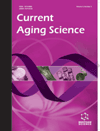- Home
- A-Z Publications
- Current Aging Science
- Previous Issues
- Volume 14, Issue 2, 2021
Current Aging Science - Volume 14, Issue 2, 2021
Volume 14, Issue 2, 2021
-
-
Nothobranchius Fish: An Untapped Resource for Studying Aging-Related Neurodegeneration
More LessAuthors: Tyrone Genade and Dale A. WilcoxNew models in which aging-related neurodegeneration more closely resembling the combination of pathologies that develop in aging humans, are needed. The fish Nothobranchius, which naturally develops such pathologies over the course of its short lifespan, is one such model. This review compares the lifespans and pathologies of different Nothobranchius strains to those of current vertebrate models of aging. Furthermore Read More
-
-
-
Beyond Physical Exercise: The Role of Nutrition, Gut Microbiota and Nutraceutical Supplementation in Reducing Age-Related Sarcopenia
More LessSarcopenia is a commonly prevalent geriatric condition mainly characterized by progressive loss of the skeletal muscle mass that results in noticeably reduced muscle strength and quality. Most of the geriatric population above 60 years of age are overweight, leading to the accumulation of fat in the muscles resulting in abated muscle function. The increased loss of muscle mass is associated with high rates of disability, po Read More
-
-
-
The Effect of Cyberspace-Based Education on the Well-Being of Caregivers of Elderly People with Dementia
More LessAuthors: Parisa Mollaei, Yadollah A. Momtaz and Parisa Taheri-TanjaniIntroduction: One of the consequences of aging is the prevalence of chronic and age-related diseases, such as dementia. Caring for patients with dementia has a negative impact on the caregiver's well-being. This study aimed to examine the impact of cyberspace-based education on the well-being of caregivers of demented elderly people. Methods: This experimental study was done on a sample of 86 caregivers of the elderly Read More
-
-
-
Changes in Peripheral Blood Biomarkers with Aging and Neurodegenerative Disorders
More LessAuthors: Marcela Lima and Cezar PestanaBackground: Aging is associated with most neurodegenerative disorders such as Parkinson's and Alzheimer's diseases. Determination of peripheral blood biomarkers represents a low invasive approach for tracking early changes in body metabolism during aging. Objective: This study addresses a cross-sectional analysis to identify changes in lipid, minerals, and antioxidant capacity as potential biomarkers to the onset of neurode Read More
-
-
-
The Effect of Mianserin on Lifespan of Caenorhabditis elegan is Abolished by Glucose
More LessAuthors: Abdullah Almotayri, Jency Thomas, Mihiri Munasinghe and Markandeya JoisBackground: The antidepressant Mianserin has been shown to extend the lifespan of Caenorhabditis elegan (C. elegan), a well-established model organism used in ageing research. The extension of lifespan in C. elegan was shown to be dependent on increased expression of the scaffolding protein (ANK3/unc-44). In contrast, antidepressant use in humans is associated with an increased risk of death. The C. elegan elegan in t Read More
-
-
-
Old Rats Are More Susceptible to Induction of Benign Prostatic Hyperplasia (BPH) at Comparative to Young Mature
More LessAims: The aim of the experiments was to find out the factors on which age-related sensitivity to the occurrence of BPH depends. Methods: 45 Male Wistar rats aged 3 and 24 months were used. In each age group, there were intact rats and animals with induced BPH (by surgical castration + testosterone injections, 25 mg/kg x 7). On the 36th day of the experiment, blood was taken from rats to determine serum testosterone, Read More
-
-
-
Relationship Between Age-Related Postural Hyperkyphosis and Sarcopenia
More LessAuthors: Gülçimen Soylu, Güzin Çakmak, Yusuf Yalvaç, Funda Datlı Yakaryılmaz and Zeynel A. ÖztürkBackground: Hyperkyphosis is one of the commonly seen disabilities in the elderly. Loss of muscle mass and function is supposed to be related to age-related hyperkyphosis. We aimed to explain the relationship between sarcopenia and hyperkyphosis in old patients in this study. Methods: 142 patients who were in the polyclinic of geriatrics of Gaziantep University Hospital were enrolled in this cross-sectional study. Hyperkyphoti Read More
-
-
-
Vitagenic Effect of Specific Bioactive Fractions of Rhodiola with Trachurus sp. Extract Against Oxidative Stress-Induced Aging in Human Amnion Derived Epithelial Cell Line: In View of a Novel Senolytic
More LessBackground: Rhodiola rosea is a herb that has been used in traditional medicine for several years, and LF is a class of lipoproteins derived from the fish Trachurus sp. (LF-T), which exhibits known anti-inflammatory activity. Objective: Investigating the anti-aging effect of Rhodiola specific bioactive fractions cluster in combination with LF-T (R-L compound) in H2O2 mediated oxidative stress-induced human amnion derived epithelial c Read More
-
-
-
Hazelnut Modulates Neurobehaviour and Ameliorates Ageing-induced Oxidative Stress, and Caspase-3-Mediated Apoptosis in Mice
More LessBackground: Organismal aging has been associated with deleterious effects in different body tissues and organs, including the brain. There have been reports from ancient medicinal scripts of the beneficial effects of nuts like hazelnut in preventing aging induced-brain atrophy and memory loss. Objectives: This study examined the potential beneficial effects of a diet supplemented with two different (Italian and Turkish) cultiv Read More
-
Volumes & issues
Most Read This Month
Article
content/journals/cas
Journal
10
5
false
en

Most Cited Most Cited RSS feed
-
-
Polyphenols and Aging
Authors: Brannon L. Queen and Trygve O. Tollefsbol
-
- More Less

